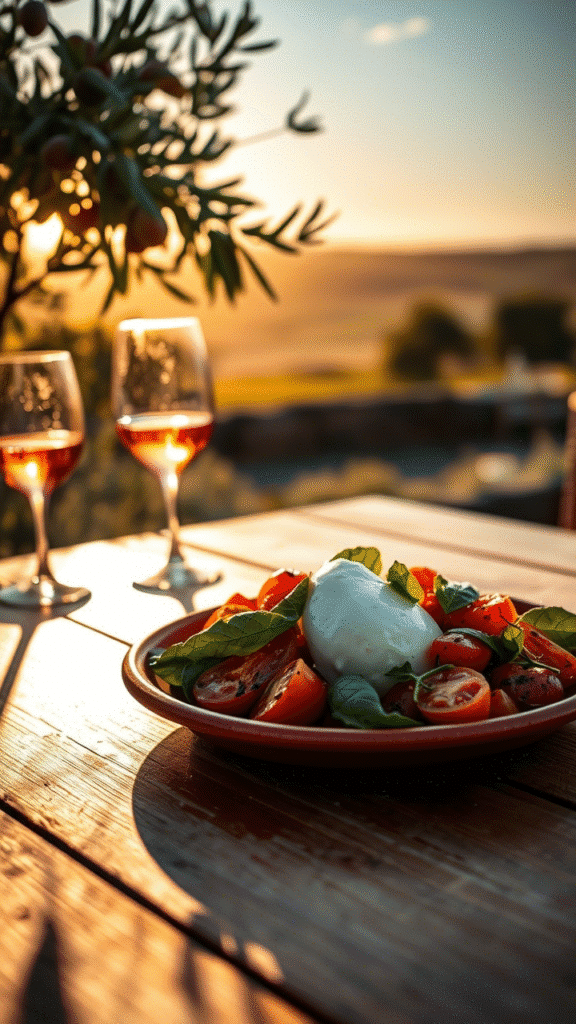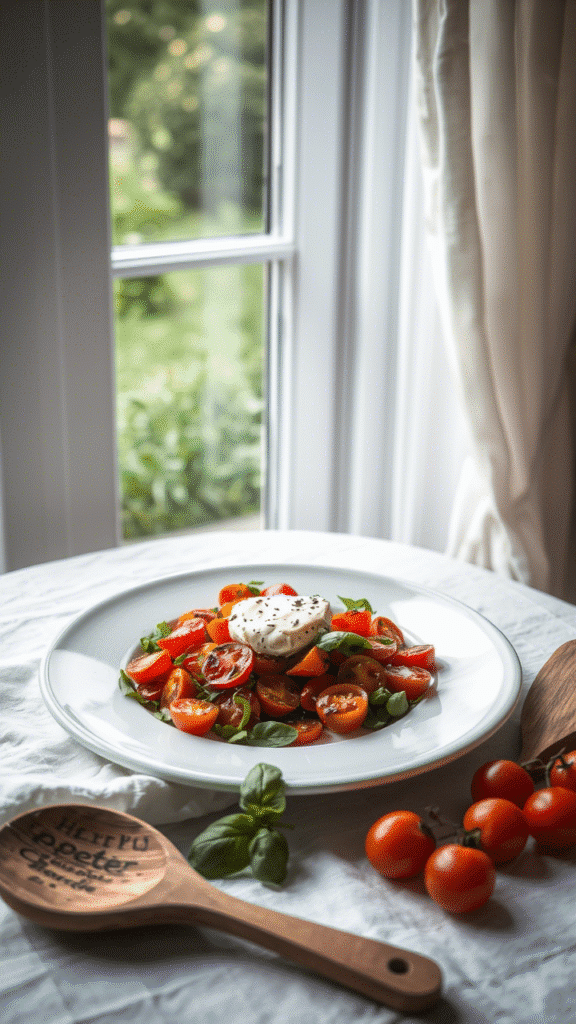I’ll never forget the first time I witnessed a diner’s reaction to our roasted tomato burrata salad. She took one bite, closed her eyes, and let out this small, involuntary sigh of pure contentment. That’s when I knew we’d cracked the code on something truly special.
This isn’t just another caprese variation—it’s an elevation of the classic that transforms humble tomatoes into caramelized jewels and pairs them with Italy’s creamiest cheese. The roasting process concentrates the tomatoes’ natural sugars while creating those coveted crispy edges that add textural contrast to burrata’s silky interior.
What sets this dish apart is its perfect balance of temperatures, textures, and flavors. Warm, jammy tomatoes meet cool, creamy cheese. Sweet meets savory. Soft meets crispy. It’s a masterclass in contrast that keeps diners coming back for more.
Understanding Your Star Ingredients
The Tomato Foundation
Your tomato selection can make or break this dish. I always reach for San Marzanos when they’re available—their low moisture content and concentrated flavor make them ideal for roasting. Roma tomatoes work beautifully too, especially when San Marzanos aren’t in season.
Cherry tomatoes bring a different dynamic entirely. Their higher sugar content caramelizes more intensely, creating these almost candy-like bursts of flavor. Mixed varieties create the most visually stunning presentations.
Avoid beefsteak tomatoes for this preparation. Their high water content means they’ll steam rather than roast, leaving you with a soggy mess instead of the concentrated flavor we’re after.
Burrata: The Crown Jewel
Real burrata should feel like holding a water balloon—the outer mozzarella shell barely containing that creamy stracciatella center. When you cut into it, that cream should flow like silk across your plate.
Temperature matters enormously here. Burrata straight from the fridge will dull all those beautiful flavors we’ve worked so hard to develop. Let it sit at room temperature for at least 30 minutes before serving. Some chefs even warm it slightly in a low oven for 2-3 minutes.
If burrata isn’t available, fresh mozzarella di bufala makes an acceptable substitute, though you’ll lose that dramatic cream revelation when the cheese is cut. Regular mozzarella simply won’t deliver the same luxurious experience.
Essential Ingredients & Smart Substitutions
For the Roasted Tomatoes:
- 2 pounds mixed tomatoes (San Marzanos, Roma, cherry varieties)
- 1/4 cup high-quality extra virgin olive oil
- 4 garlic cloves, thinly sliced
- 2 teaspoons sea salt
- 1 teaspoon freshly cracked black pepper
- 1 tablespoon balsamic vinegar (optional, for deeper flavor)
For Assembly:
- 8 oz fresh burrata (2 large balls)
- 1/4 cup fresh basil leaves
- 2 tablespoons aged balsamic vinegar
- Flaky sea salt for finishing
- Fresh cracked pepper
- Best quality extra virgin olive oil for drizzling
Substitution Notes: If burrata proves elusive, fresh ricotta mixed with heavy cream (3:1 ratio) creates a similar creamy texture. Vegan cashew cream works surprisingly well for plant-based versions.
The basil can be swapped for mint, oregano, or even young arugula. Each brings its own personality to the dish. Aged balsamic can be replaced with a balsamic reduction you make yourself—just simmer regular balsamic until it coats a spoon.
Step-by-Step Mastery

Preparing the Tomatoes
Preheat your oven to 425°F. This temperature is crucial—too low and you’ll get steamed tomatoes, too high and they’ll burn before developing those caramelized edges.
Cut larger tomatoes into irregular chunks, roughly 2-inch pieces. Leave cherry tomatoes whole but score them lightly to prevent bursting. The irregular cuts aren’t sloppy technique—they create varied surface areas that roast at different rates, adding complexity to the final dish.
Toss the tomatoes with olive oil, ensuring every piece is well-coated. This isn’t just for flavor—the oil conducts heat and helps achieve that perfect caramelization. Add the sliced garlic, salt, and pepper.
The Roasting Process
Spread tomatoes on a large rimmed baking sheet in a single layer. Overcrowding is the enemy of proper roasting—it creates steam instead of the dry heat we need for caramelization.
Roast for 25-35 minutes, checking at the 20-minute mark. You’re looking for edges that are beginning to crisp and darken while the centers remain jammy. Some pieces will cook faster than others—this variation is actually desirable.
The tomatoes are done when they’ve lost about half their moisture and developed those beautiful caramelized edges. They should smell intensely tomato-like with hints of sweetness.
Assembly Technique
Timing is everything in the final assembly. Your burrata should be at room temperature, your tomatoes still warm (not hot), and your serving plates slightly warmed.
Tear the burrata into generous pieces rather than slicing—this preserves the creamy interior and creates more interesting shapes on the plate. Arrange the warm tomatoes around and partially over the cheese, allowing some of that precious cream to mingle with the tomato juices.
The Science Behind the Magic
Roasting tomatoes triggers the Maillard reaction—that complex chemical process responsible for browning and flavor development. As moisture evaporates, natural sugars concentrate and begin to caramelize, creating new flavor compounds that simply don’t exist in raw tomatoes.

The temperature we use (425°F) sits in the sweet spot where this process occurs rapidly enough to prevent overcooking while still allowing thorough flavor development. Lower temperatures take too long, and the tomatoes can become mushy before proper browning occurs.
Garlic’s role goes beyond simple flavoring. When roasted alongside the tomatoes, it mellows and sweetens, adding depth without overpowering the delicate burrata. The thin slices ensure even cooking and prevent bitter burned garlic flavor.
The contrast between warm and cool elements isn’t just textural—it’s also about flavor perception. The warmth enhances the tomatoes’ sweetness while the cool burrata provides a creamy backdrop that tempers acidity.
Professional Plating & Presentation
Start with warmed plates—not hot, just warm to the touch. This prevents the burrata from shocking when it hits the plate and helps maintain the ideal temperature contrast.
Create height and visual interest by building layers. Start with a base of torn burrata, nestle the roasted tomatoes into and around the cheese, allowing natural valleys and peaks to form.
Drizzle the finishing olive oil from height—this creates those thin, elegant lines that photograph beautifully and distribute flavor evenly. The aged balsamic should be applied sparingly, just a few strategic drops to add dark color contrast and acidic punch.
Fresh herbs go on last, just before service. Tear them rather than cutting to prevent bruising and oxidation. The oils released from torn herbs are more aromatic than those from knife-cut ones.
Pairing Suggestions
This salad pairs beautifully with grilled proteins—especially lamb, which complements the tomatoes’ sweetness. A simple grilled chicken breast allows the salad to remain the star while providing substance.
For wine pairings, look for something with enough acidity to cut through the burrata’s richness. A crisp Vermentino or Sancerre works wonderfully. If you prefer red wine, a light Chianti Classico provides earthy notes that complement the roasted tomatoes without overwhelming the delicate cheese.
Serve alongside crusty sourdough or focaccia—something with enough structure to hold up to the burrata’s creaminess and tomato juices. The bread becomes part of the eating experience, not just an afterthought.
Seasonal Variations & Creative Twists
Summer calls for peak-season heirloom varieties in every color imaginable. The visual impact alone justifies the extra cost. Fall brings opportunities to incorporate roasted grapes or figs alongside the tomatoes.

Winter versions can feature roasted cherry tomatoes—the only fresh tomatoes worth using during colder months. Add roasted butternut squash for sweetness and substance.
Professional kitchens often prepare components ahead. Roasted tomatoes can be held at room temperature for up to 4 hours, making this an excellent choice for events or busy service periods.
Some chefs add a protein element—torn prosciutto or bresaola transforms this from salad to light main course. Others incorporate different cheeses, creating burrata “flights” with varying milk sources or aging.
Troubleshooting Common Issues
Watery Results: Usually caused by using too-wet tomatoes or insufficient roasting time. Always salt tomatoes and let them drain if they seem particularly moist.
Burned Garlic: Garlic burns faster than tomatoes. If this happens consistently, add the garlic halfway through roasting instead of at the beginning.
Broken Burrata: This happens when the cheese is too cold or handled too roughly. Always bring to room temperature and handle gently.
Bland Flavor: Under-seasoning is the usual culprit. Don’t be afraid of salt—tomatoes need more than you think. Also ensure your olive oil is high quality; cheap oil will drag down the entire dish.
The beauty of this dish lies in its apparent simplicity masking sophisticated technique. When executed properly, it showcases how fundamental ingredients can create something transcendent. Every element serves a purpose, from the carefully controlled roasting to the temperature contrasts in the final presentation.
Master this dish, and you’ll understand why it has become a staple in restaurants worldwide. It represents everything great cooking should be—technique in service of flavor, simplicity that reveals complexity, and ingredients treated with the respect they deserve.
Frequently Asked Questions?
How far in advance can I roast the tomatoes?
Roasted tomatoes can be prepared up to 4 hours ahead and held at room temperature. Don’t refrigerate them once roasted, as this dulls their flavor and creates condensation. For longer storage, they’ll keep refrigerated for 3 days but should be brought back to room temperature before serving.
Can I use different types of mozzarella if burrata isn’t available?
Fresh mozzarella di bufala is your best substitute, though you’ll lose the creamy center that makes burrata special. Regular mozzarella works in a pinch but lacks the richness. For the closest approximation, mix fresh ricotta with heavy cream in a 3:1 ratio and use that alongside torn fresh mozzarella.
What’s the best way to tell when tomatoes are properly roasted?
Look for edges that are beginning to caramelize and darken while centers remain jammy. They should have lost about half their moisture and smell intensely sweet and tomatoey. The timing varies based on tomato size and moisture content—cherry tomatoes may be done in 20 minutes while larger varieties need 35 minutes.
Why does my burrata sometimes taste bland?
Temperature is usually the culprit. Burrata served straight from the fridge has muted flavors. Always bring it to room temperature for at least 30 minutes before serving. Also, don’t forget to season with flaky salt just before serving—the cheese needs that final seasoning boost.
Can this dish be made vegan?
Yes, though it becomes quite different. Cashew cream (soaked cashews blended with water until silky) provides richness, while cultured almond ricotta adds tang. Nutritional yeast can provide umami depth. The roasted tomatoes remain the star, so focus on perfecting that technique.

Veronica is a passionate food enthusiast with over three years of experience in exploring and writing about diverse cuisines. Her expertise lies in reviewing restaurants, sharing creative recipes, and discovering the latest food trends. As the voice behind FoodieRecap.com, Anju brings fresh perspectives and culinary insights to her audience.
